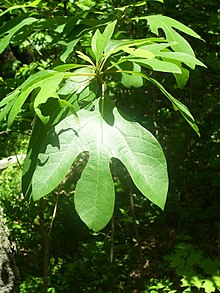Sassafras albidum
| Sassafras albidum | |
|---|---|
 |
|
| Sassafras albidum, Wanaque, New Jersey | |
| Scientific classification | |
| Kingdom: | Plantae |
| (unranked): | Angiosperms |
| (unranked): | Magnoliids |
| Order: | Laurales |
| Family: | Lauraceae |
| Genus: | Sassafras |
| Species: | S. albidum |
| Binomial name | |
|
Sassafras albidum (Nutt.) Nees |
|
 |
|
| Natural range | |
| Synonyms | |
|
|
Sassafras albidum (sassafras, white sassafras, red sassafras, or silky sassafras) is a species of Sassafras native to eastern North America, from southern Maine and southern Ontario west to Iowa, and south to central Florida and eastern Texas. It occurs throughout the eastern deciduous forest habitat type, at altitudes of sea level up to 1,500 m (5000 feet). It formerly also occurred in southern Wisconsin, but is extirpated there as a native tree.
Sassafras albidum is a medium-sized deciduous tree growing to 15–20 m tall, a canopy up to 12 m wide, with a trunk up to 60 cm diameter, and a crown with many slender sympodial branches. The bark on trunk of mature trees is thick, dark red-brown, and deeply furrowed. The shoots are bright yellow green at first with mucilaginous bark, turning reddish brown, and in two or three years begin to show shallow fissures. The leaves are alternate, green to yellow-green, ovate or obovate, 10–16 cm (4-6.4 inches) long and 5–10 cm (2-4 inches) broad with a short, slender, slightly grooved petiole. They come in three different shapes, all of which can be on the same branch; three-lobed leaves, unlobed elliptical leaves, and two-lobed leaves; rarely, there can be more than three lobes. In fall, they turn to shades of yellow, tinged with red. The flowers are produced in loose, drooping, few-flowered racemes up to 5 cm long in early spring shortly before the leaves appear; they are yellow to greenish-yellow, with five or six tepals. It is usually dioecious, with male and female flowers on separate trees; male flowers have nine stamens, female flowers with six staminodes (aborted stamens) and a 2–3 mm style on a superior ovary. Pollination is by insects. The fruit is a dark blue-black drupe 1 cm long containing a single seed, borne on a red fleshy club-shaped pedicel 2 cm long; it is ripe in late summer, with the seeds dispersed by birds. The cotyledons are thick and fleshy. All parts of the plant are aromatic and spicy. The roots are thick and fleshy, and frequently produce root sprouts which can develop into new trees.
...
Wikipedia
